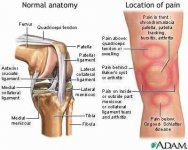Ok, just a little bit about the patellar ligament/ tendon and how it gets damaged.
Although attaching two bones (the patella and the tibia), therefore being correctly considered a ligament, the patellar ligament acts as a tendon, transferring the force generated by the quadriceps to the lower leg. While it is theoretically possible for it to be injured by contact, this is remarkably rare. The aforementioned foot pinned, knee bent mechanism also is almost unheard of in real life. These mechanisms mostly affect the true ligaments. (ACL/MCL/PCL etc), not the patellar or quadriceps tendons.
The patellar tendon is injured when the force applied by the quad exceeds the strength of the tendon or one of its attachment points. Peak force is applied during a jump and when landing from a jump. During a big jump or when landing it, a force 10 times the body weight is experienced by the tendon. The load is very technique dependent, and it is typically a awkward jump or landing that does the damage.
Imagine a rope tying the bumper of two trucks together. The trucks pull apart until tension is just applied to the rope then gently try to pull apart. That is static load. Now imagine the trucks leave 6 inches of slack in the line then both of them punch it. That is dynamic load. I think you can see why the dynamic load is more likely to break something. Perhaps the rope, perhaps a bumper. The dynamic load is likely to exceed the strength of either the rope or one of its attachments.
This is the same as the load experienced by the patellar tendon when landing a jump. This is why I was so excited to hear that Graham is landing small, gentle jumps. I would expect him to be applying gentle, static loads to the tendon at this point. To hear that he can tolerate a small dynamic load without too much pain is awesome and very optimistic news.
Don't get me wrong, there is still a long road ahead, but I would say he is ahead of schedule.
Traveling and typing on my phone, so don't expect too much from me.

